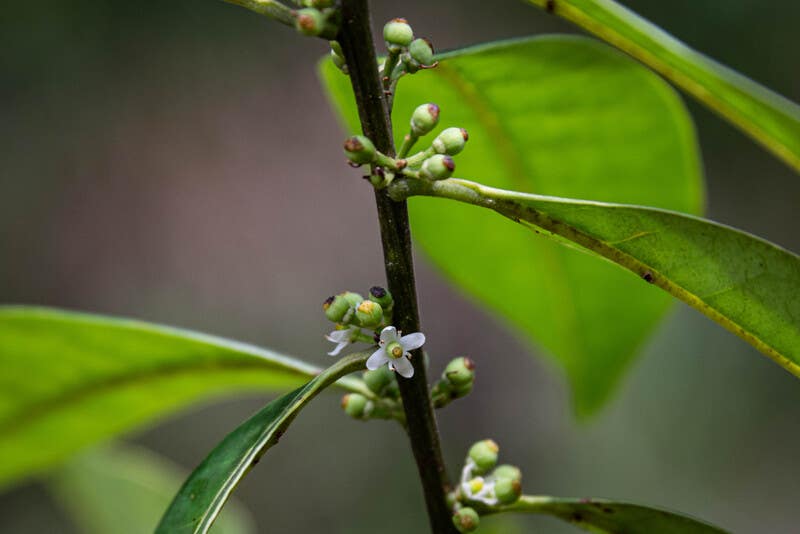When we think of finding species lost to science for decades, even centuries at a time, we often think of mysterious, hidden creatures both big and small, on the move. What comes to mind are roaming, buzzing, slithering question marks within their ecological landscapes, evading researchers until finally being rediscovered in remote corners of the world.
But what about the species that don’t move? What about the lost species found right under our noses, growing silently as the world changes around them?
Such is the case for the Pernambuco Holly (Ilex sapiiformis), a small, inconspicuous holly tree endemic to the northeastern state of Pernambuco, Brazil and one of Re:wild’s top 25 most wanted lost species by the Search for Lost Species. For almost two centuries, 186 years to be exact, the tree eluded botanists and conservationists.
That is, until March of this year, when the expedition efforts of a small team of persistent botanists and ecologists paid off, leading to the rediscovery of the illusive Ilex sapiiformis in Igarassu, a city in Pernambuco’s metropolitan municipality of Recife.
While the tree’s rediscovery rules out extinction, the conservation of the Pernambuco Holly has only just begun. Today, the expedition team, led by ecologist Gustavo Martinelli, is mapping out the next steps for bringing the Pernambuco Holly back from its current precarious status as Critically Endangered.
A needle in a haystack
As one of Brazil’s main regions for sugarcane production, Recife is a patchwork of plantations and urban neighborhoods. The region is living proof of the changes brought on by the sugar industry, which transformed the once dense biome of the Atlantic Forest into the fragmented bits of degraded patches and protected areas that remain in Pernambuco today.
It was here, nestled between dry, mostly dead forest on the banks of a silted river and opposite a sugarcane plantation, that the expedition team spotted the tree.
“Like finding a needle in a haystack,” as Gustavo puts it.
For the researchers, finding the Pernambuco Holly was surreal; not just because of the 186 years it had remained a mystery, but also because of the poor conditions the researchers found the four individuals growing in.
“Now that we practically took her out of the coffin,” says researcher at the University of São Paulo, Professor Milton Groppo when speaking of the tree, “We can really start to think about the plant’s conservation.”
From pollination to medical possibilities
From birds to bees, the Pernambuco Holly is one of a group of plants under the genus Ilex, that play crucial roles in ecosystems when it comes to the pollination process. Like many other hollies, Ilex sapiiformis has small, fragrant white flowers that produce nectar attracting different types of bees, and deep red berries making hollies like this a favorite of bird species in the region.
For Professor Groppo, finding the tree also brings up possibilities for promising medical and commercial purposes.
“The tree, like other hollies, are from a family that here, in the south of Brazil, are related to what we call chá mate, which has been widely used by Indigenous peoples as a stimulant. People here have now learned to drink chimarrão, a drink made with mate, a very close relative from the same genus as Ilex sapiiformis. It’s likely that this plant must have some type of stimulant in its secondary compounds and we can explore the economic and medical uses of this species.”
A race to action
While the rediscovery of the tree is a hopeful reminder of how nature can still surprise us, it is also a race to action. Now classified as Critically Endangered, the Pernambuco Holly’s best chance at avoiding extinction is for researchers to find more of its kind.
Alongside Jardim Botânico de Recife and other local partners and institutions, Martinelli is calling for additional searches for the tree, envisioning a process to save the seeds and germinate them into seedlings, tracking the genetic variation and establishing a captive breeding program.
In the meantime, local researcher and project assistant for the expedition, Juliana Alencar, conducts routine site visits to the trees. She explains that the expedition also discovered several seedlings in the area. The team had hopes that the seedlings would prove promising, but Juliana shares that since her last visit to the site, the seedlings around the trees have been washed away by heavy rains.
While the clock is ticking to search for more trees and develop the breeding program, sometimes, the fight against time and the elements can be balanced by the dedication of those working on the frontlines of conservation. The same spirit, tenacity and ingenuity that led the small team of botanists to rediscover the Pernambuco Holly remains just as present in looking toward the future of its conservation.
“Whenever we find a lost species, we never want it to become lost again, or become Extinct,” says Christina Biggs, lost species program officer for Re:wild. “In cases like the Pernambuco Holly, where the entire known population is in one small area, there are things conservationists can do to make sure that it receives emergency help.”
Since there are now only three known Pernambuco Holly trees in existence, the patch of forest could meet the criteria to become classified as an Alliance for Zero Extinction (AZE) site. AZE sites are Key Biodiversity Areas (KBA) that urgently need conservation help because the species living in them are highly threatened and don’t occur anywhere else on the planet.
However, first more searches are needed to determine if the Pernambuco Holly truly only exists in a single patch of forest or if other members of the species have managed to survive elsewhere. The expedition team had originally compiled a list of 11 possible locations where the holly could still survive, but has not been able to search all of them yet.
“We're supporting their team through this process,” says Andrew Snyder, Key Biodiversity Area coordinator for Re:wild. “It's in the beginning phases right now. Once the team better understands the holly’s current distribution, they can prioritize relevant stakeholder consultations and begin the formal KBA proposal process.”
In order to give the Pernambuco Holly the greatest chance of recovering, an AZE site would ideally encompass the entire area where the species is found.
AZE sites are eligible for additional funding to help protect the biodiversity they hold. In addition to those resources, often international funding and development institutions do not finance projects proposed in AZE sites–which can help protect AZE trigger species.
“Putting this site on the map helps highlight its global importance. With AZE sites in particular, we know that if something detrimental happens to the site, as far as we know, we are guaranteed to have a species go extinct,” says Snyder. “Mapping this site and putting it out there for public attention raises awareness for just how important this site is globally, relative to other similar sites.”
Laura Moreno is a writer and communications specialist from the world of ocean conservation, working to share the stories that drive the protection and restoration of the wild. She is passionate about elevating the voices that inspire us from the front lines of conservation and exploring the species that remind us of the magic of what’s worth protecting.
When she’s not writing or looking at photos of nudibranchs, she spends her time surfing between one of two west coasts, California and Portugal, and digging for hidden sonic gems in record shops. Laura loves finding the right words, sounds, movements and music that make good stories come alive.




